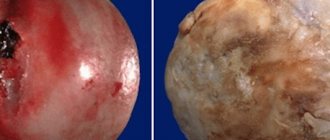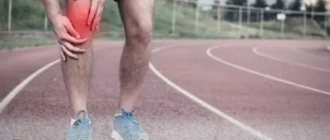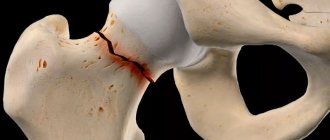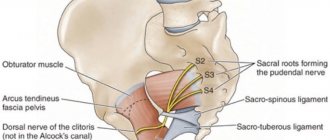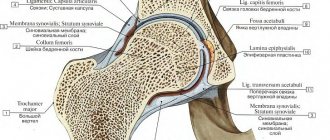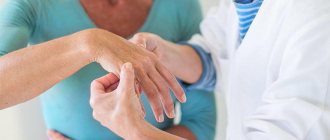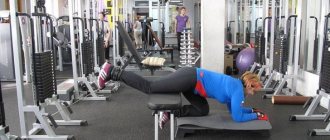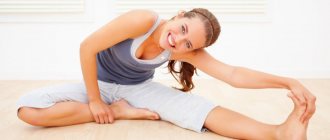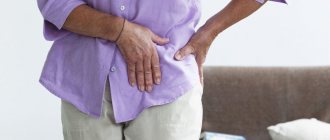The older a person gets, the more difficult it is to move due to disruption of large joints. This is due to the destruction of bone tissue and aging of the cartilage surface. When the hip joint is affected, these problems sharply limit a person’s capabilities, which dictates the need to search for relevant therapeutic measures.
Most often, it is precisely this type of joint destruction that patients begin treatment for. But it’s too late not only to do gymnastics, but also to do any other procedures.
Not everyone is ready to immediately realize that the only radical option for getting rid of pain and difficulty moving in the joint is hip replacement. One of the ways to restore the functionality of a joint with coxarthrosis is therapeutic exercises. Despite the fact that exercises cannot save the joint, they can help develop the ligamentous-muscular system, which will have a positive effect on the postoperative period.
The essence of physical training
The main problem that activates the process of destruction of the hip joint is a decrease in the amount of synovial fluid. The glands of the shell of the same name, lining the articulation cavity, are responsible for its production. As soon as there is less synovial fluid, the mobility of the articular surfaces is impaired and the friction between them increases. This leads to a narrowing of the joint space, which in severe situations completely immobilizes the patient. This is how arthrosis of the hip joint occurs.
This is a real image of the femoral head with stage 2-3 arthrosis. Look carefully and think, will gymnastics help in this case?
Medicines can slow down the progression of the disease, but the process cannot be stopped. At an unfavorable moment, arthrosis will lead to serious pain, which will significantly affect the quality of life. However, even at the moment when it becomes clear that endoprosthetics surgery is no longer possible, therapeutic exercises will prove extremely useful for improving the functioning of the joint, both before and after surgery.
The effect of exercises carried out at home is as follows:
- stimulation of blood flow around the damaged joint;
- restoration of muscle performance and prevention of muscle atrophy;
- stimulation of the glands of the synovial membrane due to intensive blood supply;
- reducing the progression of arthrosis;
- stretching and mobilization of the ligamentous apparatus;
- general strengthening of the body and immune system.
After any gymnastic exercises, the mood improves, which leads to an increase in a person’s ability to fight the disease.
A network of blood vessels that supplies tissues with useful substances that promote rapid regeneration of the cartilage surface.
However, not only the psychological factor influencing the patient plays a role in activating restoration processes in the hip joint. There are also quite tangible changes that the patient will feel after treatment through regular exercise. These include:
- increased range of motion in the joint;
- pain relief;
- increased strength in a limb;
- easier walking;
- reduction in the frequency of colds;
- improving quality of life.
Although gymnastics will not radically change the situation, the joint will still have to be replaced with prosthetics; it will help reduce rehabilitation time and speedily restore motor activity in the postoperative period. This will be possible thanks to developed muscles and well-developed tendons, as well as stable blood flow in the hip joint.
There are many options for gymnastic exercises done at home. But the effectiveness of their treatment is completely different. The most relevant training is that proposed by a professional exercise therapy instructor, as well as the classic methods of Evdokimenko and Bubnovsky. A video of classes with a physical therapy specialist clearly shows the optimal set of exercises.
Minimally invasive endoprosthetics in the Czech Republic: doctors, rehabilitation, terms and prices.
Find out more
Therapeutic prevention
Some medical experts believe that you can get rid of osteoarticular diseases of the musculoskeletal system by changing the quality and diet. You should avoid eating fermented foods, smoked meats, and foods with biochemical preservatives . It is also necessary to reduce the consumption of pickled, salty foods and sugar. It is best to satisfy your gastronomic cravings with foods of plant origin.
Even a person’s psychological attitude to stress is important, since rheumatic diseases of the hip joints are directly related to this. In simple terms, the stress hormone actually eats away the cartilage of the hip joint. If there is no release or discharge of nervous stress, then a spasm of the blood vessels in the joint area occurs. Most often, people with unstable mental health turn to rheumatologists, orthopedists and traumatologists.
Take care of yourself and always be healthy!
Gymnastics Evdokimenko
Since the early 2000s, Dr. Evdokimenko’s practice of therapeutic exercises has become widespread in medical practice. Today he is a well-known rheumatologist, a specialist in joint restoration through physical training. Has the status of academician at one of the Moscow technical universities. His medical career began in 1984, when the future specialist received a paramedic education. The further period is associated with practical work and study at the institute, which Pavel Evdokimenko graduated from in 1994. From that moment on, he chose the direction of physical therapy for various osteo-articular pathologies as his specialization.
Pavel Evdokimenko.
Further work at the arthrosis center in Moscow, and then subsequent improvements at the Research Institute of Rheumatology of the Russian Academy of Medical Sciences, prompted the doctor to develop a set of exercises that help prolong the active function of the joints. In 2003, the first book was published, telling in detail about the method of Pavel Evdokimenko. Today, exercise is recognized throughout the world and helps slow the progression of coxarthrosis. Even in the most difficult situations, when surgical intervention is already inevitable, the use of therapeutic exercises can dramatically reduce postoperative rehabilitation.
Although gymnastics can heal arthrosis, it cannot completely replace the installation of a prosthesis. However, there are significant positive qualities that are discussed below.
- Strengthening the thigh muscles. The less their atrophy, the easier it is to move the limb. A strengthened muscle frame will help reduce the load on the painful joint, thereby slowing down the progression of arthrosis.
- Activation of blood flow in the synovium. Improving the blood supply to the affected hip helps reduce the rate of reduction of the joint space. This is achieved by increasing the production of synovial fluid. As a result, friction in the joint is reduced and functionality is increased.
- Reducing osteoporosis. Achieved by increasing active movements in the joint. The processes of rarefaction of bone tissue are reduced, as the work of osteoblasts is activated.
- Strengthening the back frame. Since physical training stimulates muscle activity not only in the thigh, but also in the buttock and lumbar region, the load on the affected joint and spine is further reduced. This makes movement easier and also relieves pain.
- Increasing joint resistance to physical stress. This is achieved through long training.
- Easy adaptation in the postoperative period during joint replacement. Since the muscles, as well as the ligamentous apparatus, are in an optimally developed state, even the first steps after surgery are easier to bear, and rehabilitation will be short and painless.
Gymnastics video:
All exercises according to Evdokimenko’s method are performed many times. No major changes in the joint will occur within a month of training, so you need at least six months. But the systematic use of gymnastics promotes significant clinical improvement. The patient will feel a significant improvement in walking, as well as a decrease in pain.
What is osteoarthritis (coxarthrosis)?
Deforming arthrosis, coxarthrosis or osteoarthrosis of the hip joint is a complex of clinical manifestations confirming the onset of degenerative-dystrophic destruction of the osteoarticular, muscular and ligamentous joints in the hip section of the skeletal frame. Painful signs of the disease are accompanied by limited mobility in the joints, muscle atrophy, and shortening of the limbs .
Damage to the left joint. This is what it will look like if measures are not taken at the initial stage of the disease.
The causes of the development of clinical pathology may be hereditary predisposition, old spinal trauma, curvature of the spinal axis, inflammatory processes of an infectious nature in the osteo-articular and muscular sections.
An advanced form of clinical pathology forces a person to take potent medications - painkillers aimed at reducing pain, and anti-inflammatory drugs - to eliminate the inflammatory process.
Photograph of the head of the hip joint with grade 3 osteoarthritis.
A program of drug and physiotherapeutic treatment agreed with the attending physician, and the prescription of therapeutic and preventive exercises for the hip joints will strengthen the musculoskeletal system and return the patient to the ability to move without painful discomfort.
List of exercises according to Evdokimenko
The author offers 10 of the most relevant exercises that will help quickly stabilize the joint. In total, the therapeutic gymnastics course includes more than 50 different exercise options, but Pavel Evdokimenko believes that it is impossible to do without the dozens of the most significant. The entire list of exercises for the treatment of coxarthrosis is presented below.
- Leg lift. A simple exercise that is performed at a slow pace. You need to start with the affected joint. Standing on a hard surface, you should raise your leg bent at the knee. Then hold it for 45 seconds, then slowly lower it. Repeat with the healthy leg. The frequency of execution is 2 times a day.
- Dynamic leg raises. Repeat the first exercise at a fast pace. You need to hold your leg suspended for no more than 2 seconds. Number of repetitions – 15. Multiplicity – twice a day.
- Lying leg raises. Starting position – with your back on the floor, legs slightly apart. You should slowly raise the limb bent at the knee and hold it for 60 seconds. One-time execution is enough. Then repeat at a dynamic pace, at least 15 times with each leg.
- Leg raises and extensions. The exercise is suitable only for trained people. While lying on your back, you need to raise your closed limbs, without bending, up, hold in this position for 5 seconds, then spread them apart without lowering them. Close your legs and place them on the floor. Repeat at least 7 times.
- Lateral leg raises. Starting position – lying on the right half of the body. The legs are one on top of the other. You should raise your left leg, hold it for 10 seconds, then lower it. Repeat 10 times, then roll over to your left side and do the exercise with your right leg.
- Lateral foot lift with rotation. Starting position: lying on your right side. The straightened left leg must be raised up as high as possible, and then rotate the foot clockwise. Lower the limb, repeat 10 times. Then turn over onto your left side and do the exercise with your right leg.
- Lifting the pelvis. Lying on your back, with your knees bent, you should rest your elbows on the floor and lift your buttocks above the surface with the strength of your limbs. Hold in this position for 20 seconds, then lower. Repeat 10 times. If you have physical capabilities, the speed of the exercise can be increased, as well as the number of approaches.
- Long lean forward. Starting position – sitting on the floor, legs straightened as much as possible and spread no more than 10 cm wide. The essence of the exercise is to reach your feet with your hands, pull your body forward and remain in this position for 1 minute. Daily exercises stretch the ligamentous apparatus. The frequency of execution is only 1 time per day.
- Seated leg raises. Starting position – sitting on a chair. The legs are lowered down and bent at the knee joints. It is necessary to raise the limbs one by one to the maximum possible height, but holding for no more than 5 seconds. The repetition rate is at least 15 times with each leg.
- Knee bends. This is a slightly difficult exercise to understand, but it’s easier to do it step by step. To begin, take a sitting starting position with your back against the wall. Legs are straightened as much as possible and spread shoulder-width apart. The next step is to bend the sore leg at the knee joint, but do not lift the heel off the floor. Then reach the knee joint with your hands and smoothly, rocking it a little, try to bring it as close as possible to the healthy leg. There will be discomfort in the hip joint, but then you should relax and contract the thigh muscles. The pain will go away quickly. Repeat up to 10 times once a day.
All exercises are done daily, so it is important to set aside time and not miss classes. Within a month of training, tangible results will appear. If you need to undergo hip replacement surgery, then this duration of the course of exercises is sufficient for excellent preparation for surgical manipulation. If, on the advice of a doctor, endoprosthetics can be postponed, then classes should be continued for up to six months. The ideal option is one in which daily training is done for life. A video of all of Pavel Evdokimenko’s exercises will give a clear idea of the technique for performing them.
Minimally invasive endoprosthetics in the Czech Republic: doctors, rehabilitation, terms and prices.
Find out more
General recommendations
Training must be carried out regularly. Don't skip exercises without good reason, exercise every day. Work at a calm pace, movements should be as soft as possible and without jerking. Make sure you are breathing correctly.
Follow the principle of gradually increasing loads. It is impossible, without being well prepared physically, to immediately break records for the number of repetitions that are indicated in each point of the covered exercise. Start with the minimum possible, gradually increasing the number of repetitions. For example, out of the 8 indicated repetitions, for starters, it’s better to do 3-4, but efficiently and without overload, and then add one or more exercises at a time, focusing on how you feel.
When performing therapeutic exercises, carefully monitor your sensations, do not allow new pain to appear and the usual pain syndrome to intensify. Developing, increasing pain is a sign that it is urgently necessary to reduce the intensity or frequency of the exercise performed, and perhaps even stop exercising for that day. If pain caused by training persists for more than 2 hours, you should temporarily stop exercising and consult a doctor for advice as soon as possible.
Gymnastics according to Bubnovsky
One of the famous specialists in kinesitherapy - movement treatment, is Professor Sergei Bubnovsky. His entire career, starting from his student days, was devoted to joint diseases. The purpose of the developed set of exercises is to increase the motor activity of the hip joint, thereby preventing the development of ankylosis. The essence of the technique is simple - the more the patient makes active movements in the joint, the longer the synovial fluid will remain in it. This slows down the progression of coxarthrosis, and patients are given the opportunity to postpone surgery. There are only two main conditions for performing training - movements must be smooth, and classes must be conducted daily.
Doctor Bubnovsky.
Below are the most famous exercises of Professor Bubnovsky.
- Knee bending. A simple exercise that is accessible even to people with little training. It is necessary to lie on your back, bend your legs at the knee joints with maximum effort, and then immediately straighten them. Holding in a bent position is not required, as frequency of movement is important. Repeat 15 times.
- Pulling the knee towards the stomach. It is important to perform the exercise with maximum dedication, even through slight pain. Its essence is simple - lying on your back, raise your knee, clasp it with your hands and try to reach it to your stomach. Multiplicity of execution: 15 times with each leg.
- Lifting the buttocks. Lying on your back, bend your legs at the knee joints without lifting your heels from the floor. Then, using tension in the muscles of the limbs, raise the buttocks as high as possible. You can't help with your hands. Repetition frequency – up to 15 times.
- Leg raises. Starting position: lying on your stomach. The legs are extended as much as possible and are on a hard surface. It is necessary to alternately raise the straightened leg and immediately lower it. Repeat up to 20 times.
- Spreading the feet. Starting position – sitting on a chair. The legs are pressed tightly against each other. It is necessary to spread your feet, trying to move them to the sides as much as possible. There will be some pain in the hip joint, but this is not an obstacle to continuing exercise. The repetition rate is 10 times.
Despite the numerous differences, there are many similarities in the exercises of Bubnovsky and Evdokimenko. The main thing is that in both cases it is possible to stabilize the functioning of the hip joint, which has a positive effect not only on maintaining its mobility, but also on accelerating rehabilitation in the postoperative period. Professor Sergei Mikhailovich Bubnovsky proposed a set of exercises designed specifically for early recovery after endoprosthetics. Their essence lies in slowly spreading and bending the legs at the knee joints, starting with the simplest movements. Similar developments were proposed by Dr. Sergei Makeev, but his exercises are complemented by breathing exercises and self-massage of the hip joint. This helps to enrich the body with oxygen, which increases the metabolic rate in the affected joint, thereby preventing the progression of arthrosis. You can learn more about Sergei Makeev’s exercises by watching the video.
Description of rehabilitation stages
Basic recovery after hip replacement takes 10 weeks. Of these, 3 weeks are the early phase, from the third to 10 weeks are the late stage. And all this time it is necessary to fruitfully carry out tasks and exercises for rehabilitation after hip replacement, dictated by the surgeon and rehabilitologist. Together, specialists create an effective physical therapy regimen.
The essence of training exercises is repeated, regularly repeated and consistently increasing physical activity, which gradually improves motor activity, dynamically improves and restores performance. After the entire specified period of time after surgery on the hip joint, rehabilitation does not completely end. All the achievements that the patient has been pursuing for so long and finally achieved the cherished painless freedom of movement must be consolidated.
Wonderful sanatoriums that provide proper rehabilitation after partial replacement and total hip replacement are located in the Leningrad region, Krasnodar region, and Karelia. If we talk about foreign European resorts, Teplice and Jáchymov, located in the Czech Republic, are clearly the leaders here.
Gymnastics for arthrosis
Lesions in the hip joint occur with a frequency of up to 10% among all population groups. If we take only the age over 50 years, then the prevalence of pathology is significantly higher. Up to 70% of people suffer from coxarthrosis, and another third of this figure suffers from tendon damage. This disease is called trochanteritis. It occurs due to overload in the work of the limb. The tendons stretch, microcracks appear, and then aseptic inflammation develops. Untreated trochanteritis leads to limited movement in the hip joint, which contributes to the progression of arthrosis.
X-rays can distinguish arthrosis from trochanteritis. In the second case, the joint space does not change.
Whatever the symptoms, exercise will help alleviate them, which will affect the patient’s activity in a positive way. However, exercise alone is often not enough. Doctors of various specialties use different treatment regimens for the disease. The most relevant ones are discussed below.
- Plasmapheresis. The essence of the procedure is to cleanse the blood of immune complexes that damage bone tissue. The method is not bad in preventing the progression of the disease, but it is not able to restore already impaired joint functions. It is necessary to repeat the procedure many times, since immune complexes will again accumulate in the plasma.
- Taking NSAIDs. Drug therapy is aimed only at relieving acute inflammation and pain. Does not reduce the progression of joint space narrowing. Negatively affects the gastrointestinal tract, causing erosions and ulcers in the upper sections.
- Swimming. Exercising in the pool helps improve range of motion in the joints. These workouts can perfectly complement gymnastics done at home.
- Introduction of stem cells. The advertising of the method is excellent - aging slows down, which means destructive processes in the joint are reduced. In practice, the technique does not work, as has been proven by numerous controlled studies, so it is no longer used at present.
- Unique healing gymnastics. This is the main method that has truly positive results on the functioning of the joint. Neurologist professor Irina Bubnova considers this method of treatment mandatory for all categories of patients.
However, no method can compare in effectiveness with endoprosthetics. Only surgery can radically change the quality of life of a patient suffering from deforming arthrosis of the hip joint. But as an additional aid to patients to facilitate postoperative rehabilitation or slow the progression of coxarthrosis, physical exercise helps better than other treatment methods.
Introductory briefing
After hip replacement, rehabilitation lasts an average of 3 months. It consists of stages, for each of them its own system of treatment and rehabilitation measures has been developed, based on physical exercises and auxiliary procedures. A step-by-step therapeutic effect on the prosthetic segment allows you to prevent complications, quickly eliminate swelling and painful signs, thoroughly develop the limb, restoring the functionality of the leg.
A good and calm stitch approximately on the 3rd day after the operation.
We hope that you have thought about such a device in advance.

